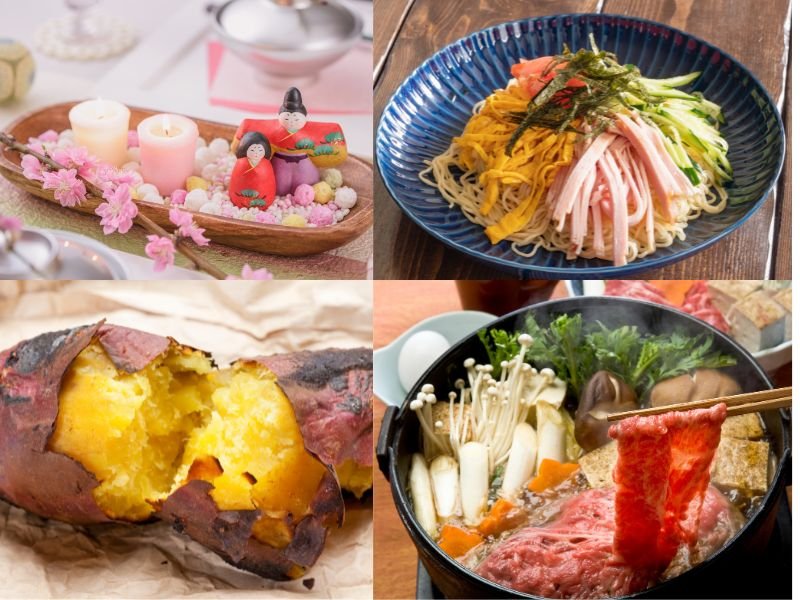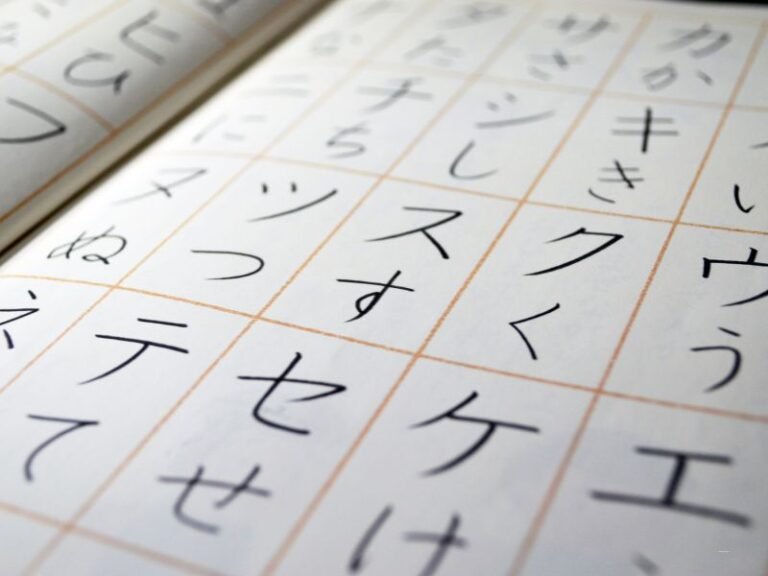Delicious Japanese Seasonal Food Guide: Eat Like a Local in Japan
Visiting Japan? Then don’t miss the Japanese seasonal food!
In Japan, we have a unique food culture that changes with the seasons. Every few months, fresh ingredients appear on the menu—only available for a short time. We call this “Shun” (旬), which means food that is in season and at its best. These ingredients are full of flavor, deeply connected to nature, and often used in local dishes.
In addition to seasonal ingredients, Japan also has special foods tied to seasonal traditions, such as New Year’s Osechi or Hina-arare for Hinamatsuri (Girls’ Day). These foods are not only delicious—they carry cultural meaning and are part of celebrating important events.
If you’re planning a trip to Japan, I hope this guide helps you enjoy the Japanese seasonal food treasure hunt! Look out for these delicious items as you travel—you may find them at restaurants, convenience stores, markets, or even at festivals. If you find them, try them!
Japanese Seasonal Food In Spring (March–May)
Shun-Food in Spring
Takenoko たけのこ (Bamboo shoots)
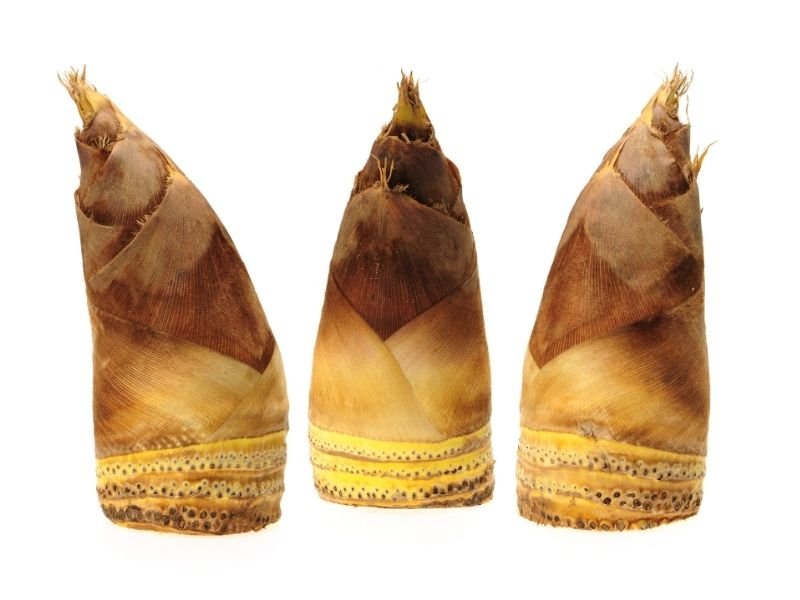
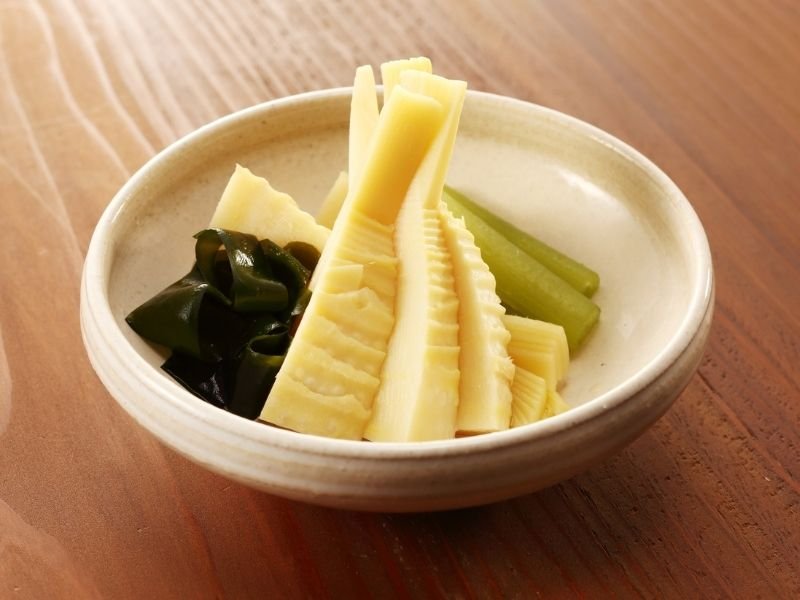
Crunchy and fresh, often simmered in dashi (see right side picture) or added to rice. You may find Takenoko food in Japanese restaurants or bento boxes at Supermarkets or Convenience stores.
Nanohana 菜の花 (Rapeseed blossoms)
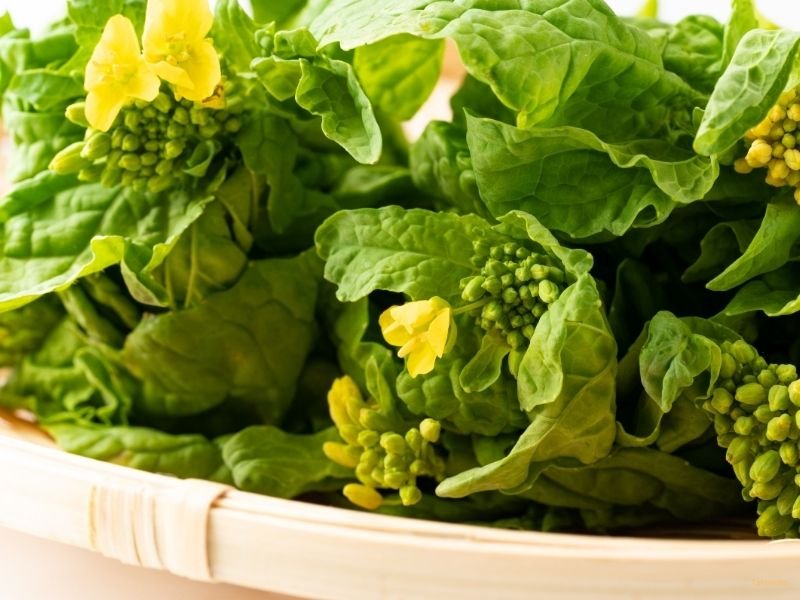
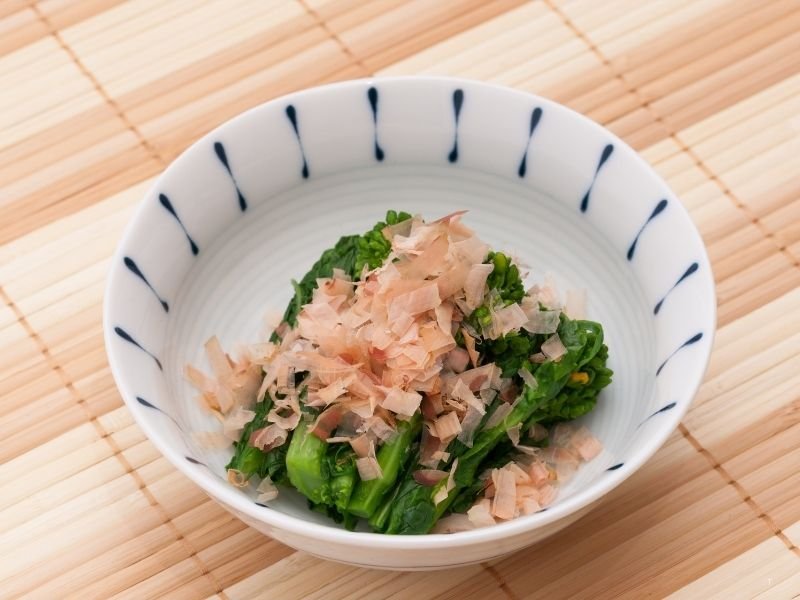
Slightly bitter green vegetable. We boil Nanohana and eat it with soy sauce or mustard dressing. You may find Nanohana dish at Japanese restaurants and supermarkets.
Ichigo 苺 (Strawberries)
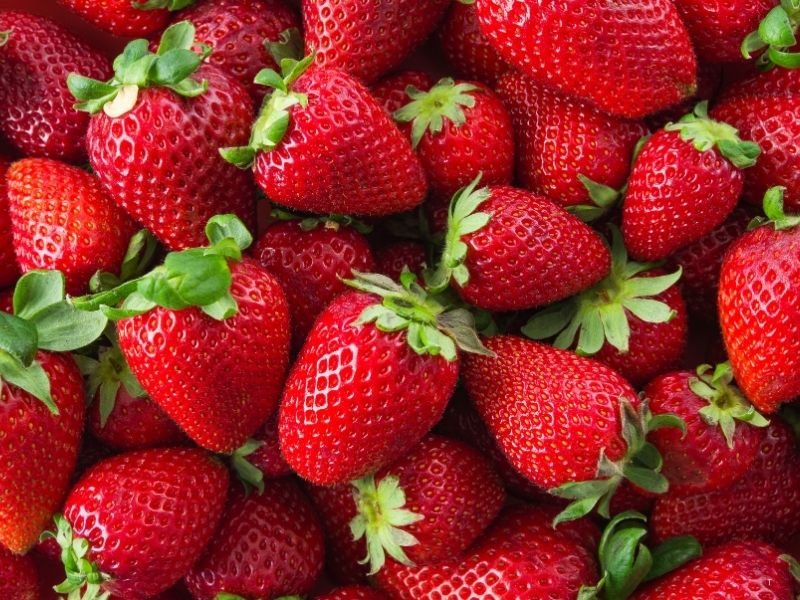
Yes, we have strawberries in the USA too, but Japanese strawberries are super sweet and juicy. If you’re in Japan during spring, please try them—especially at dessert cafés! Many cafes in Japan have campaigns of strawberry sweets this season.
Asari あさりand Hamaguri 蛤 (Clams)
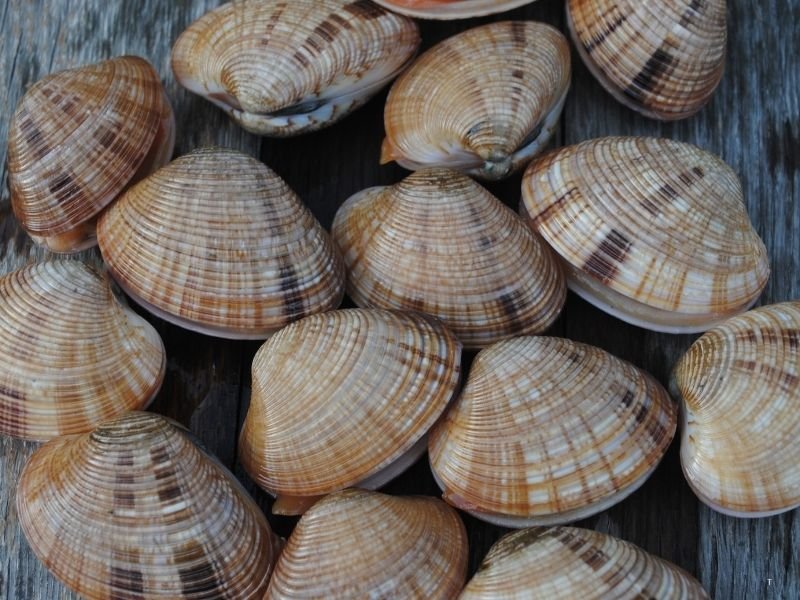
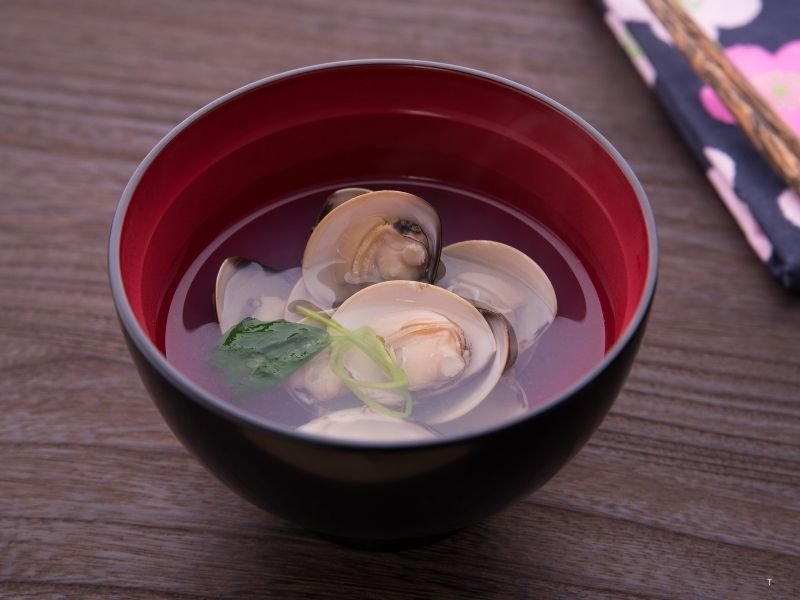
Perfect in miso soup or steamed rice, these clams are full of umami flavor.
Shirasu しらす (Baby sardines)
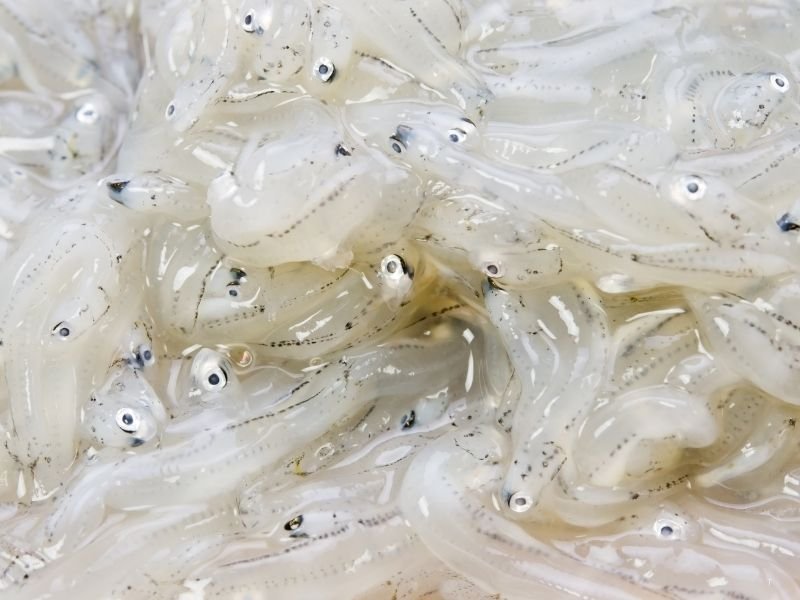
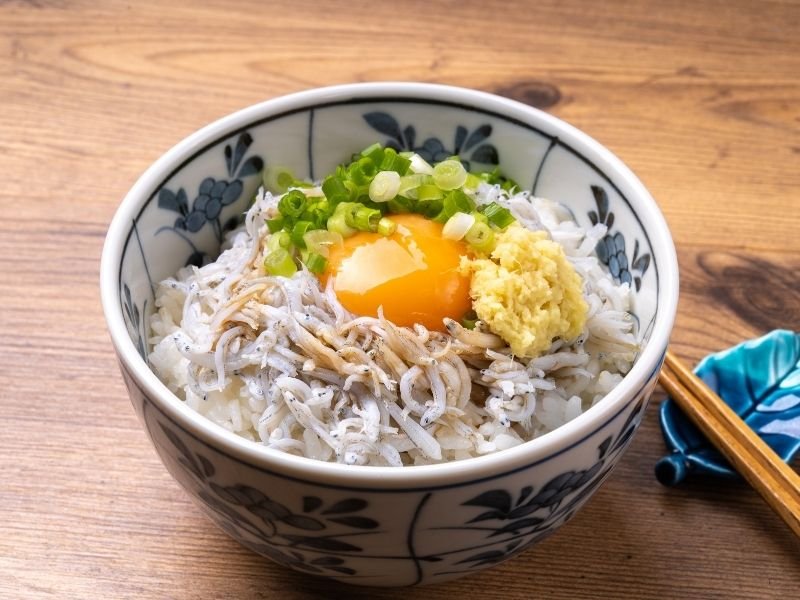
Tiny white fish are often served over rice or tofu. Light and flavorful! If you visit the Kanagawa area in Japan, Enoshima, Kamakura are very famous for Shirasu.
Seasonal Traditional Foods in Spring
Hina-arare ひなあられ
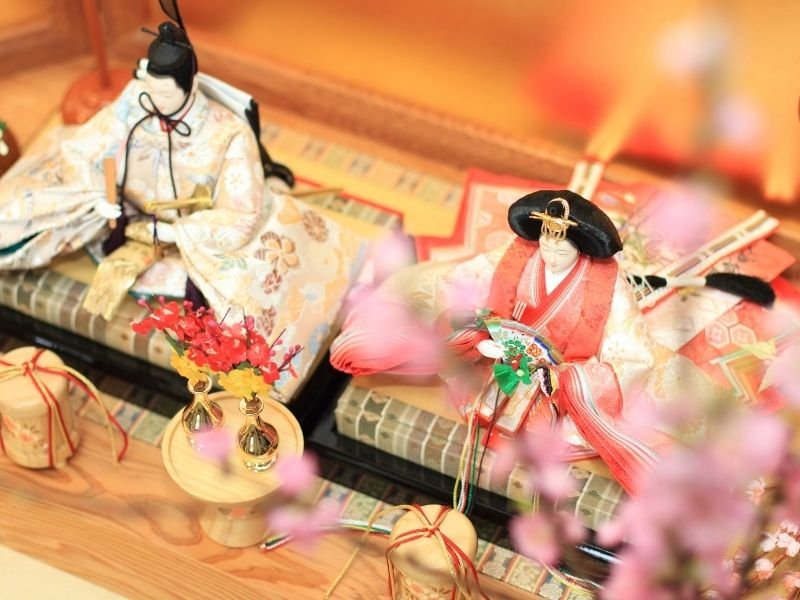
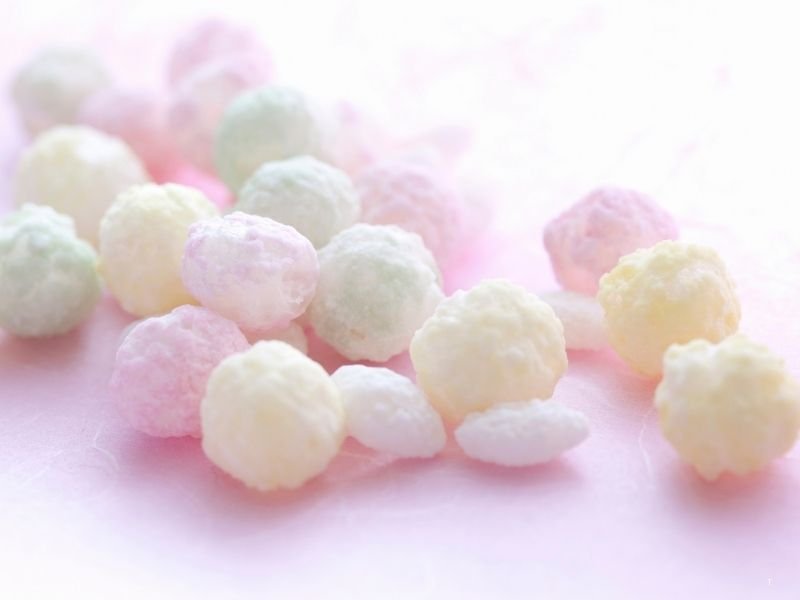
Colorful rice crackers are eaten during Hinamatsuri (March 3), a day to wish for girls’ health and happiness. Not too sweet. You can enjoy this like snacks during your travel.
Sakura Mochi 桜餅 and Kashiwa Mochi 柏餅
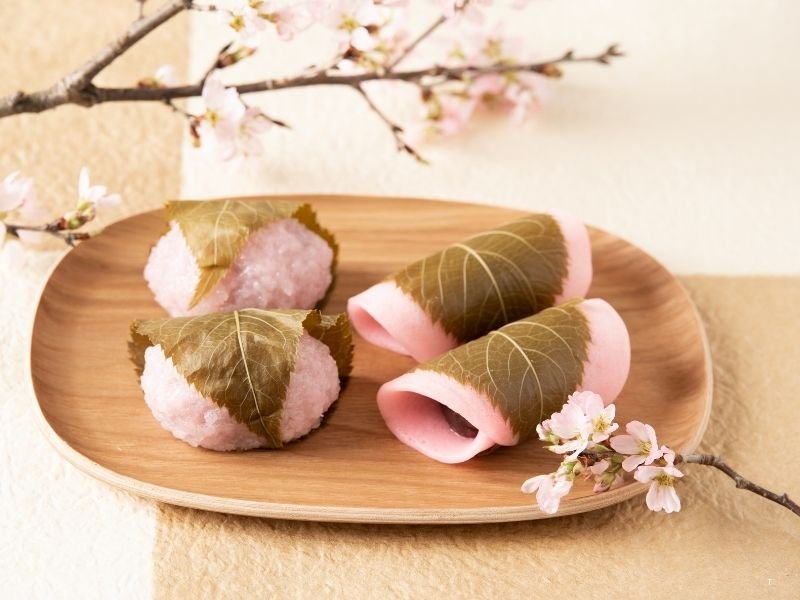
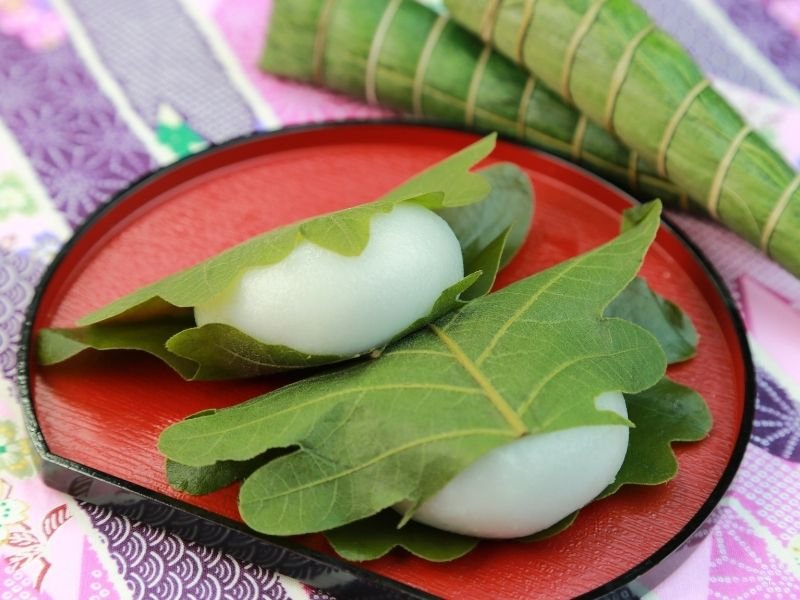
Sakura Mochi (Left side picture) is a sweet pink rice cake filled with red bean paste and wrapped in a salted cherry leaf. Tastes like spring!
Kashiwa Mochi (Right side picture) is eaten on Children’s Day in May. We wish the boy health and happiness. It’s a chewy rice cake (Mochi) wrapped in an oak leaf with a sweet filling inside.
Japanese Seasonal Food In Summer (June–August)
Japanese summers are hot and humid, so summer food is refreshing and hydrating. Festivals and fireworks bring fun street snacks too!
Shun-Food in Summer
Unagi 鰻 (Eel)

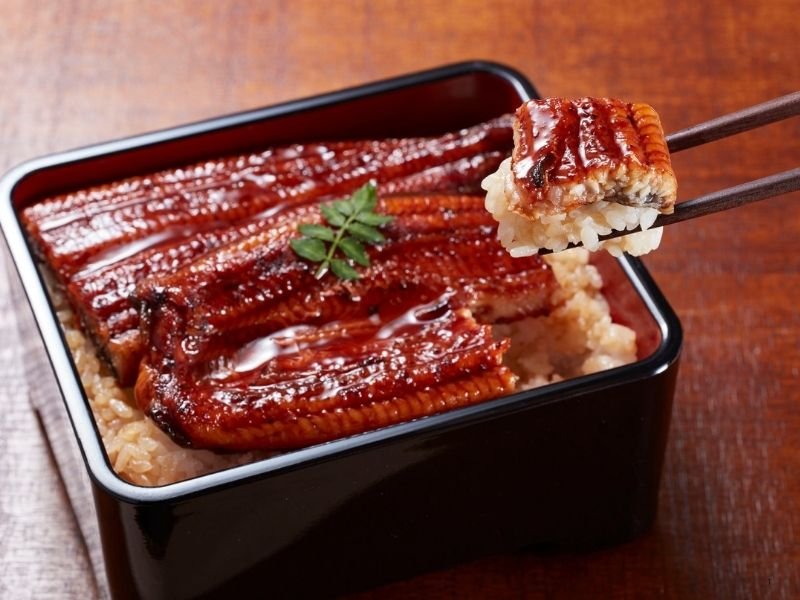
Grilled and glazed with a sweet soy sauce. It’s rich in nutrients and eaten to boost energy during the hottest days. Traditionally eaten on Doyo no Ushi no Hi (土用の丑の日) for stamina in summer.
You can buy it at the supermarkets, but I recommend eating Unagi at Unagi Unagi-specific restaurant. It is a bit expensive but super delicious. I miss Una-ju (Right side picture)very much…!
Suika スイカ and Edamame 枝豆
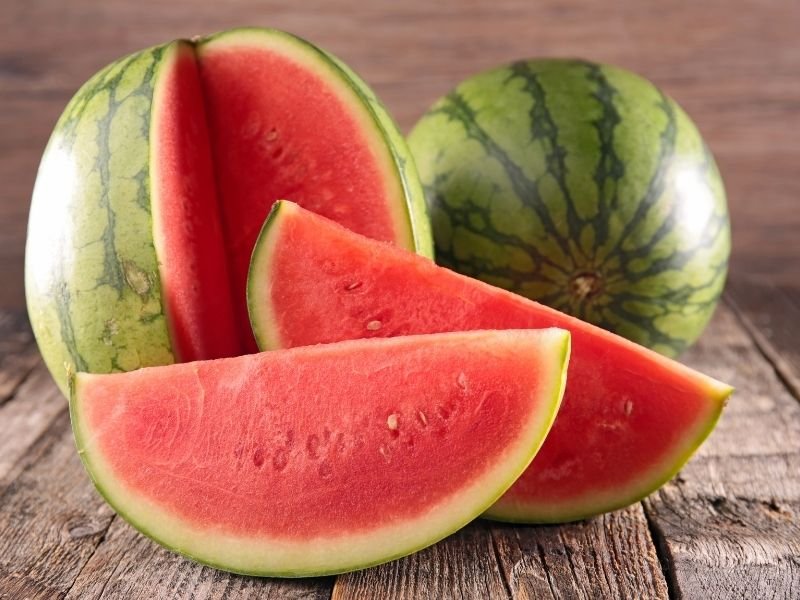
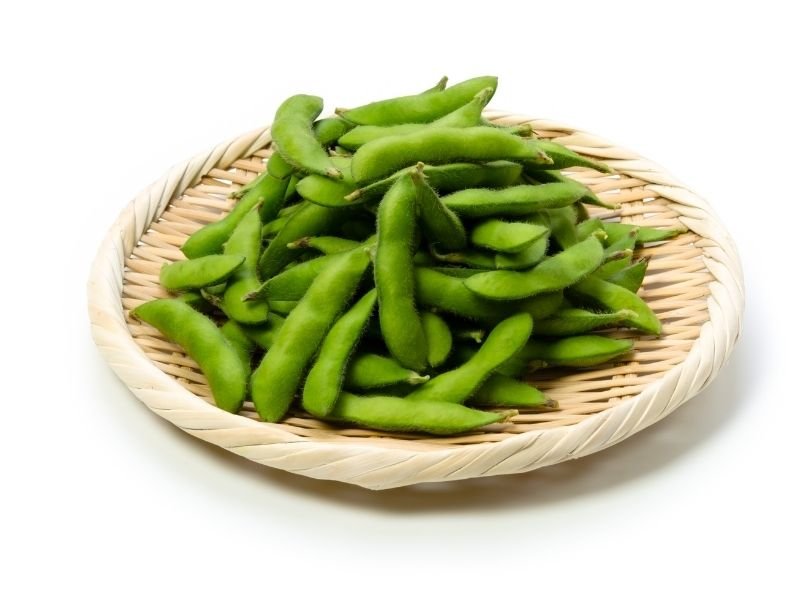
- Suika (Watermelon) – Similar to the USA, but why not compare the taste? Popular during beach trips and picnics. I see watermelons sell in the USA all year round, but in Japan, we see it only in the summertime.
- Edamame – You might know this snack from Costco, but Japanese summer edamame is extra flavorful and sweet.
Melon メロン
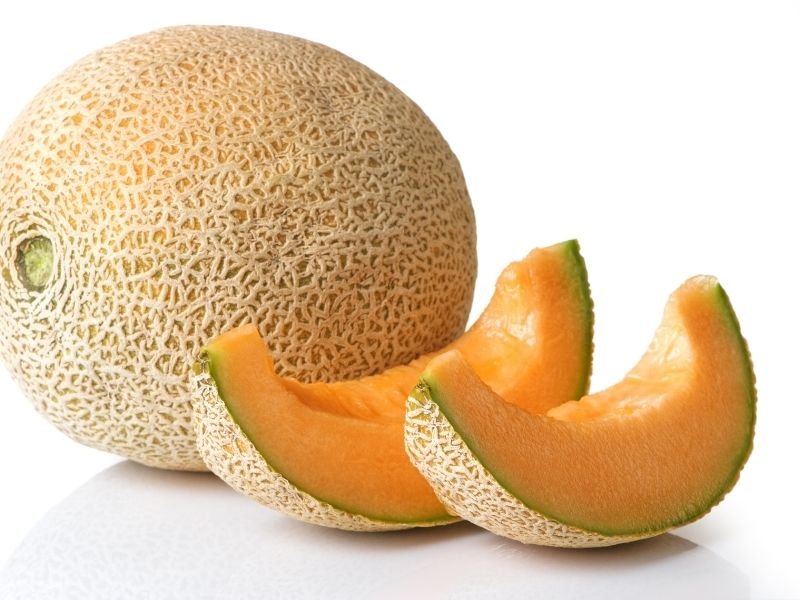
Japanese melons are often expensive but taste like candy. Try it once—you’ll understand why it’s a luxury gift item.
Goya ゴーヤ(Bitter melon)
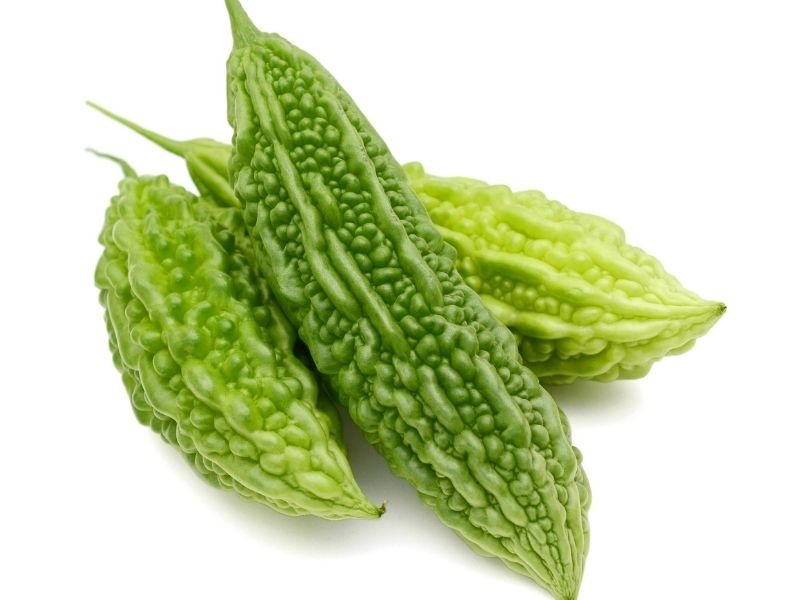
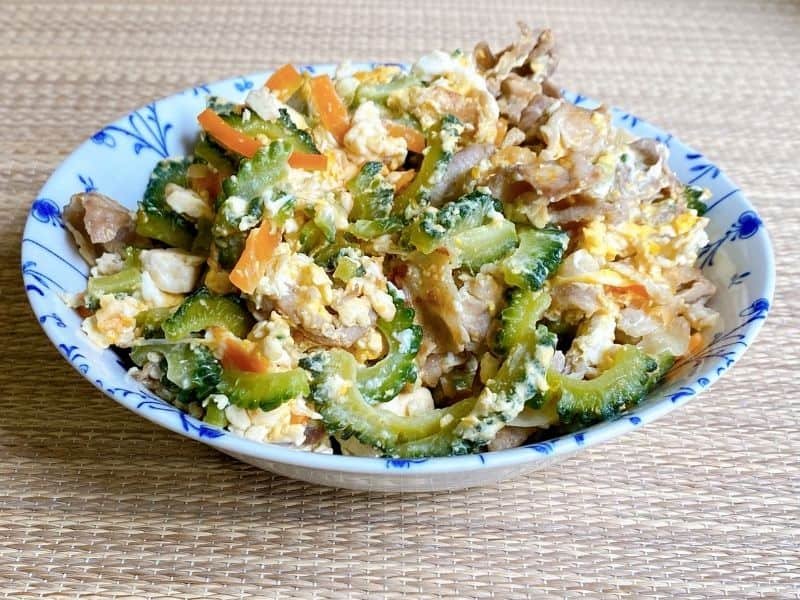
A healthy but strong-tasting vegetable, especially common in Okinawan cooking. You might think it is too bitter for the first time.
Yaki-tomorokoshi 焼きとうもろこし(Grilled Corn)
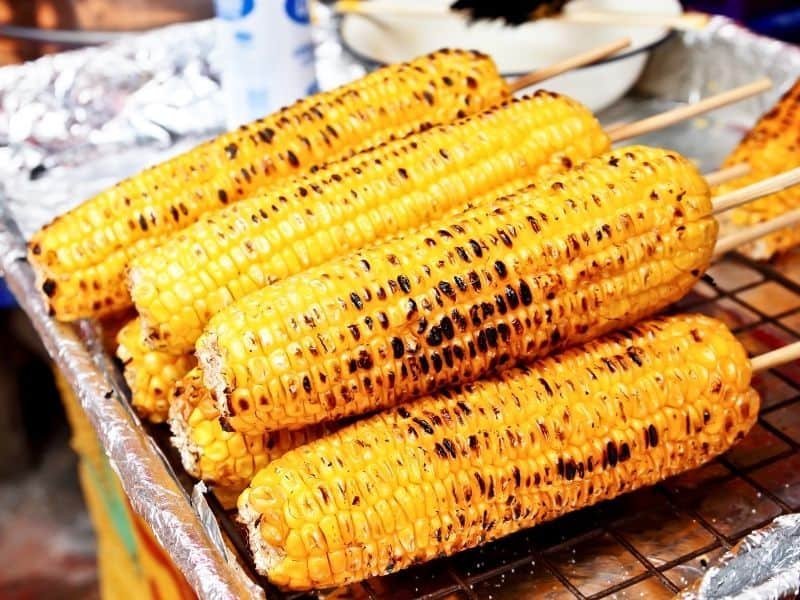
Brushed with soy sauce and grilled over fire. A popular summer festival snack!
Seasonal Traditional Foods in Summer
Somen 素麺
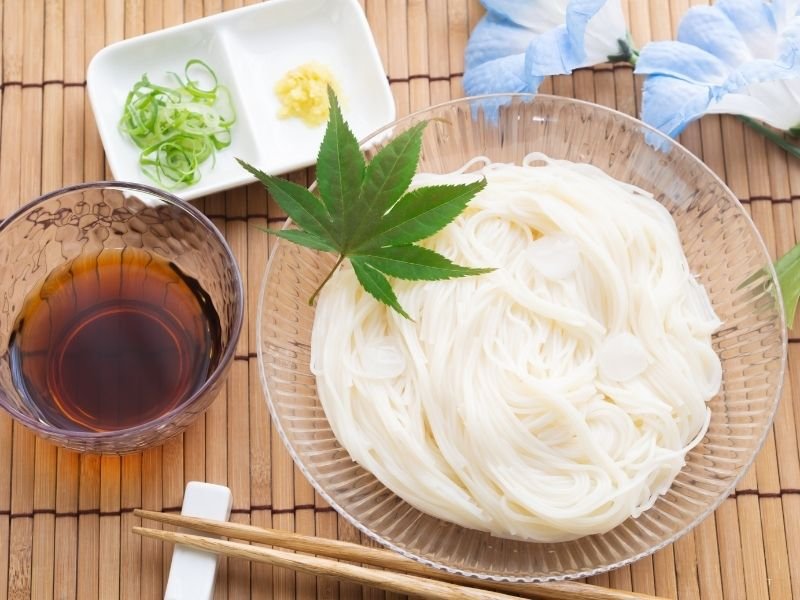
Somen – Thin, cold noodles served with dipping sauce. In some places, you can try. Nagashi Somen, where the noodles slide down a bamboo flume and you catch them with chopsticks. A fun summer experience!
Hiyashi-Chuka 冷やし中華
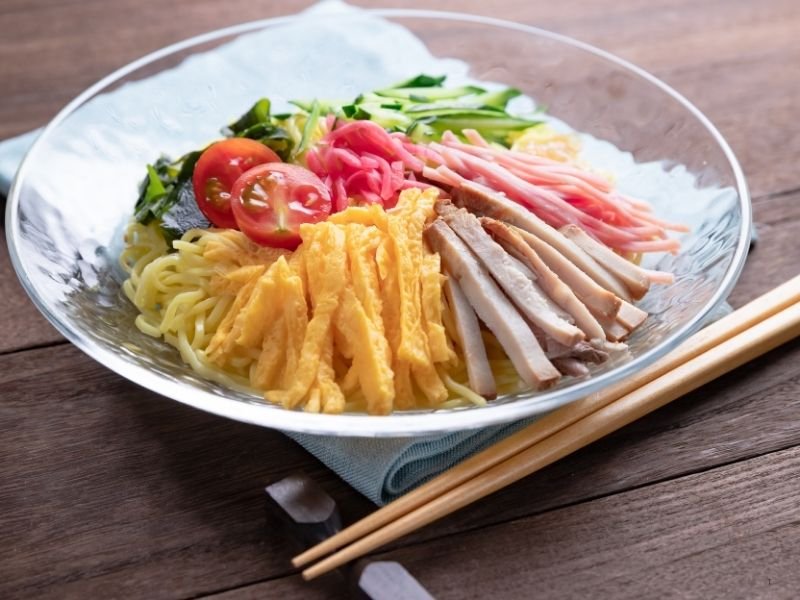
Cold ramen noodles with colorful toppings like egg, cucumber, and ham.
A Bit sour taste, but it is tasty. You can eat at Ramen restaurants, and you can also buy it at convenience stores or supermarkets.
Kakigori かき氷
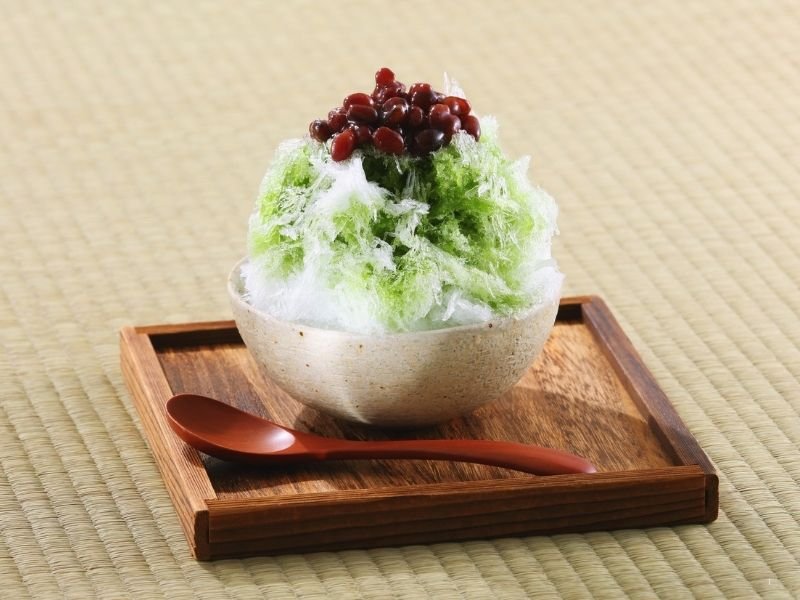
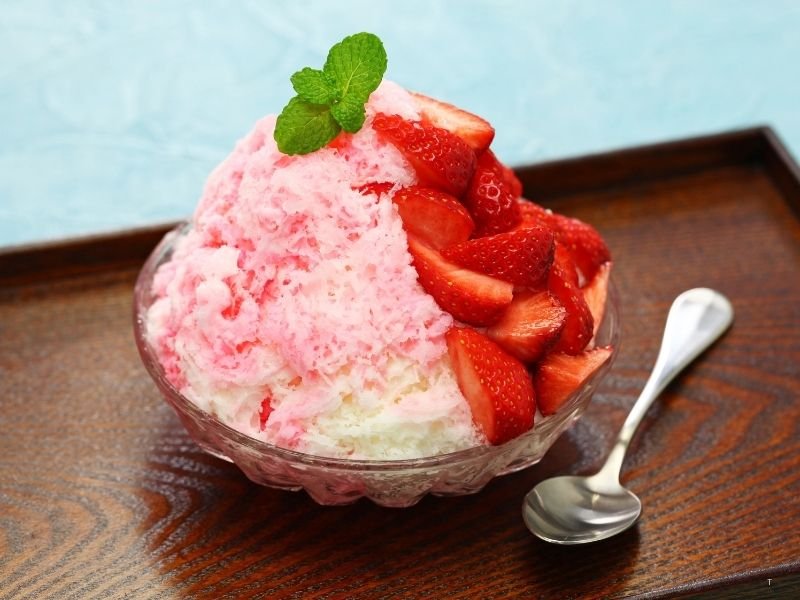
Kakigori – Japanese shaved ice dessert. Unlike the icy versions in the U.S., kakigori is finely shaved and melts instantly in your mouth. Try a high-quality one at a specialty café!
Japanese Seasonal Food InAutumn (September–November)
Autumn is harvest season in Japan. The air cools down, and food becomes rich and hearty. It’s the perfect time to enjoy earthy and sweet flavors.
Shun-Food in Autumn
Sanma 秋刀魚
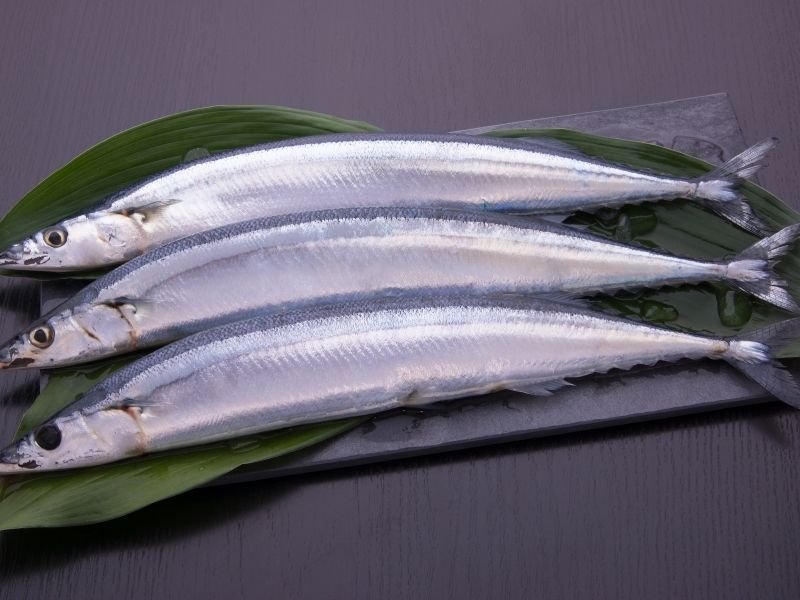
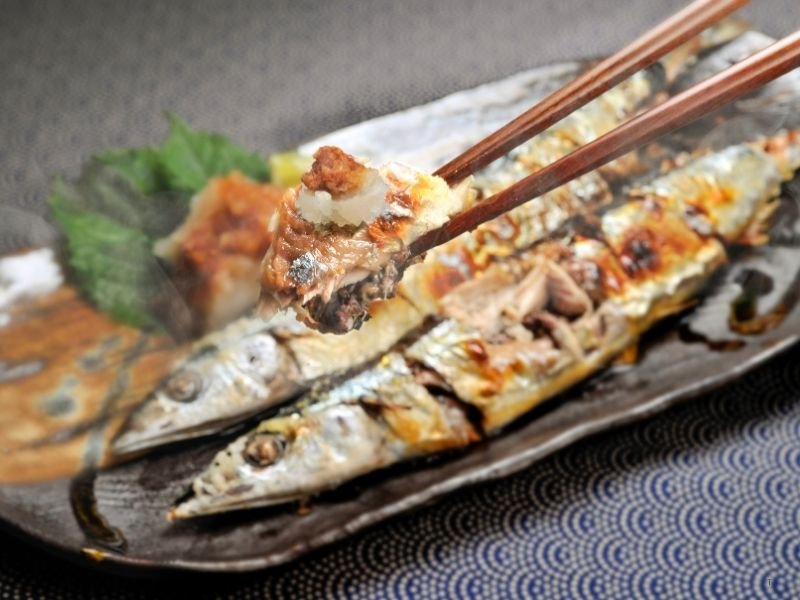
Grilled with salt and served whole. A symbol of autumn in Japanese cuisine. It might be a bit difficult to eat because grilled sanma is served whole, and you need to remove all the small bones in it. But I would like you to try it once because almost all Japanese love sanma, including me.
Matsutake 松茸(Pine mushrooms)
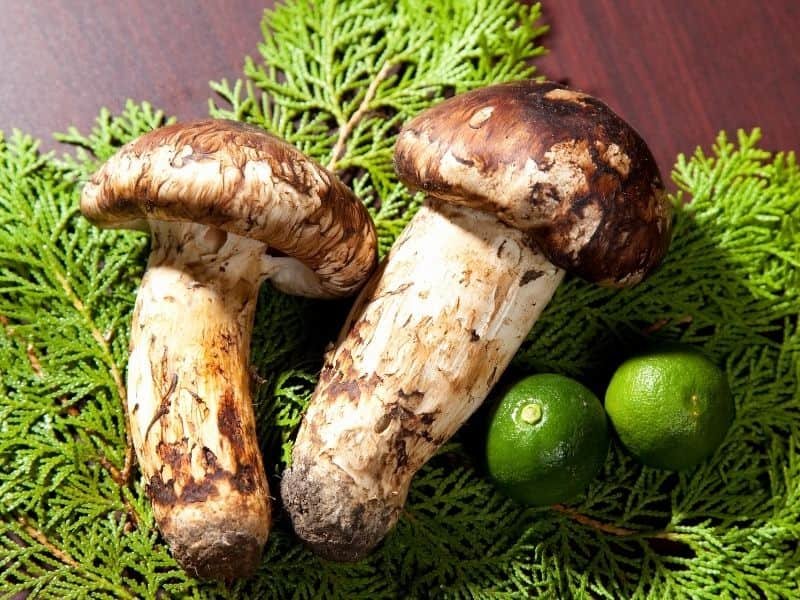
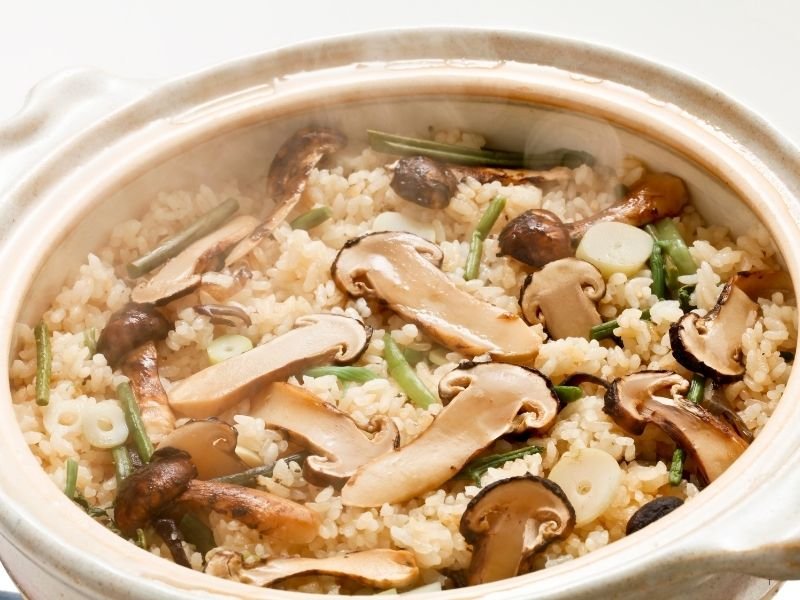
A rare and expensive mushroom with a strong aroma. A delicacy in autumn. This mushroom is super expensive, so we don’t eat it so often. But the aroma of this mushroom is fantastic. If you have the opportunity to eat, try it!
Budou ぶどう(Grapes)
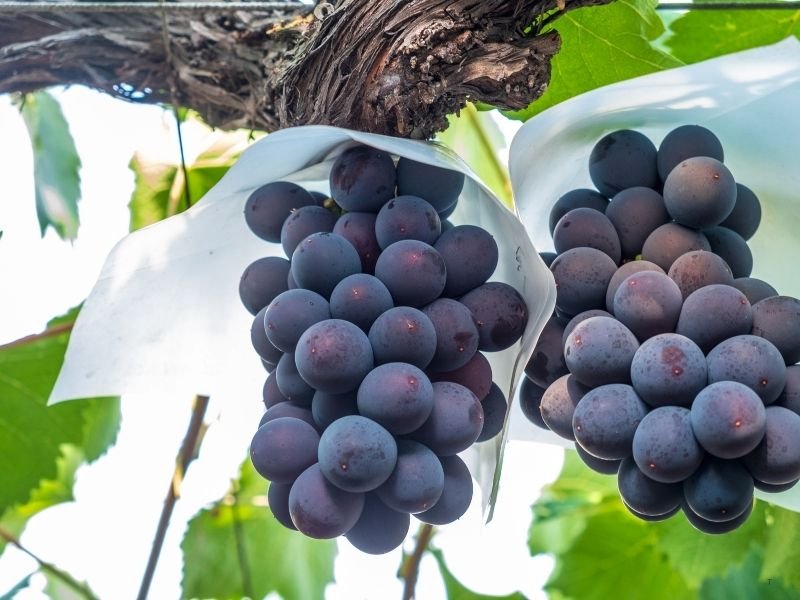
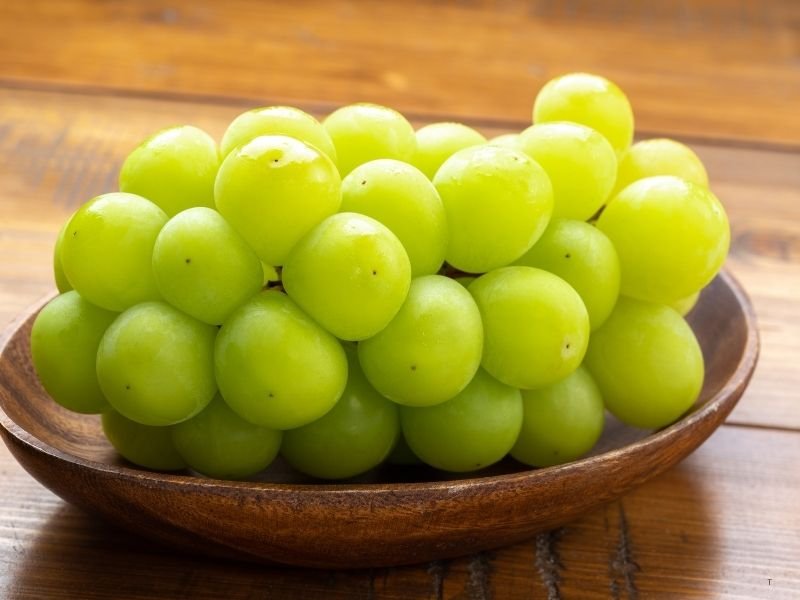
These large, sweet grapes are incredibly juicy and different from those in the USA. You can find a wide variety of grapes in the supermarkets this season. My favorite is Kyoho (巨峰: see the upper side picture).
Seasonal Traditional Foods in Autumn
Tsukimi Dango 月見だんご
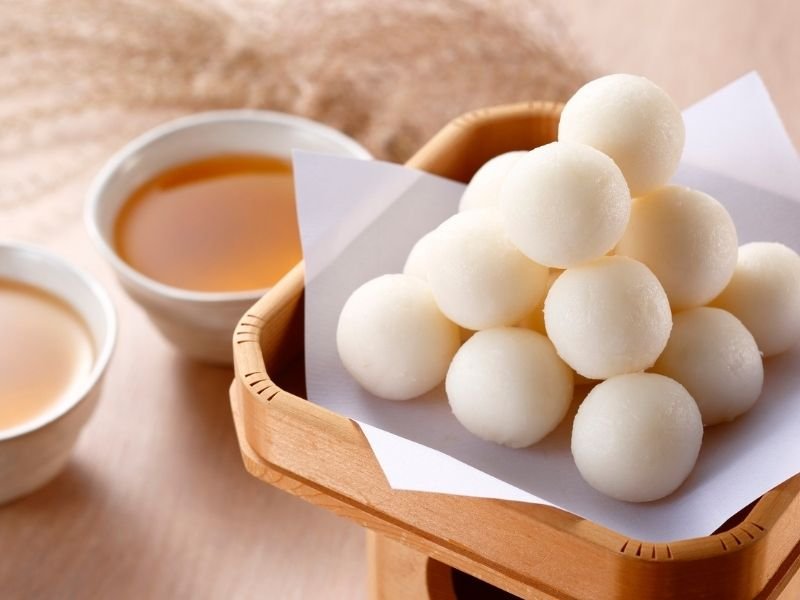
Rice dumplings offered during Tsukimi, Japan’s moon-viewing festival.
Kuri Gohan 栗ご飯
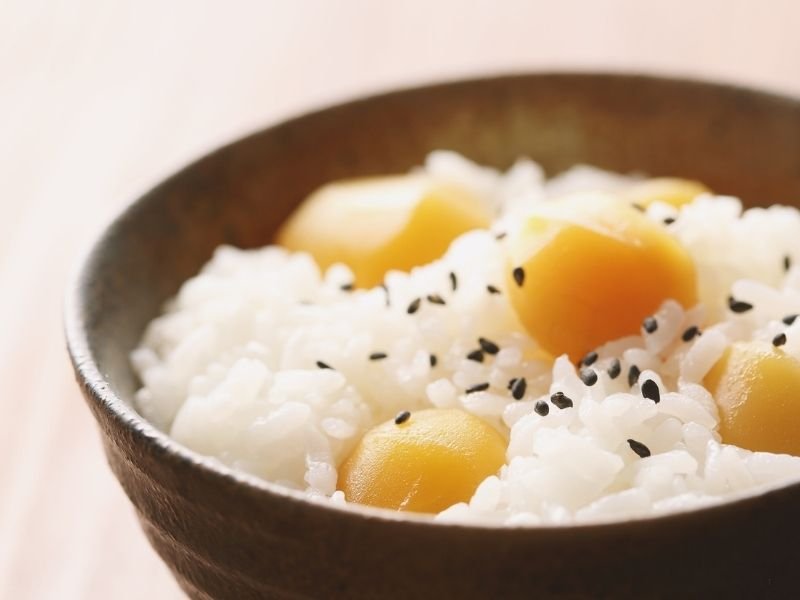
Chestnut rice, often served in autumn meals. Simple and sweet taste.
Ohagi お萩
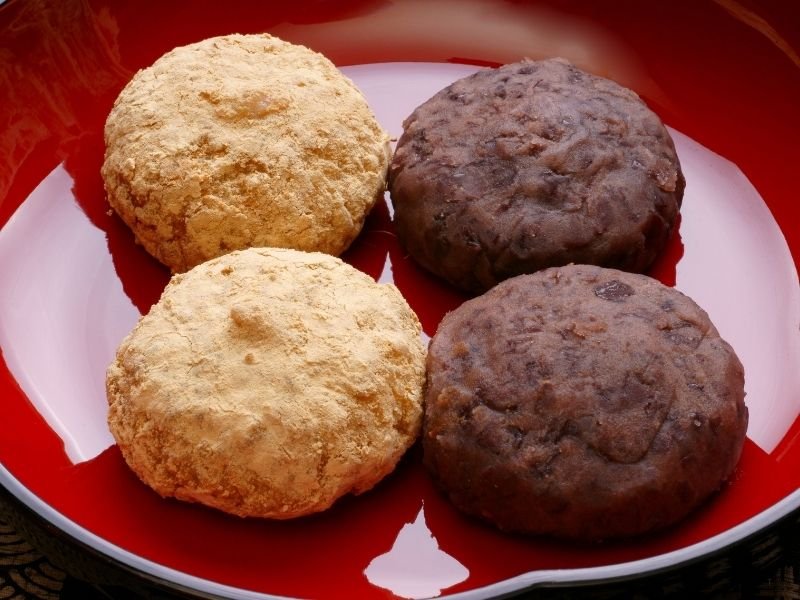
Ohagi are soft rice balls coated in sweet red bean paste, roasted soybean flour (kinako), or black sesame. They’re chewy, mildly sweet, and a classic Japanese treat that’s often enjoyed in autumn.
These sweets are traditionally eaten during Ohigan (お彼岸), a Buddhist custom observed around the autumn and spring equinox. It’s a time when people visit their family graves, clean the grave sites, and offer food like ohagi to honor their ancestors.
Even if you’re not visiting during Ohigan, you can often find ohagi in supermarkets or traditional sweets shops in autumn—definitely worth a try if you want to taste something meaningful and seasonal!
Yaki-Imo 焼き芋 (Sweet Potato)
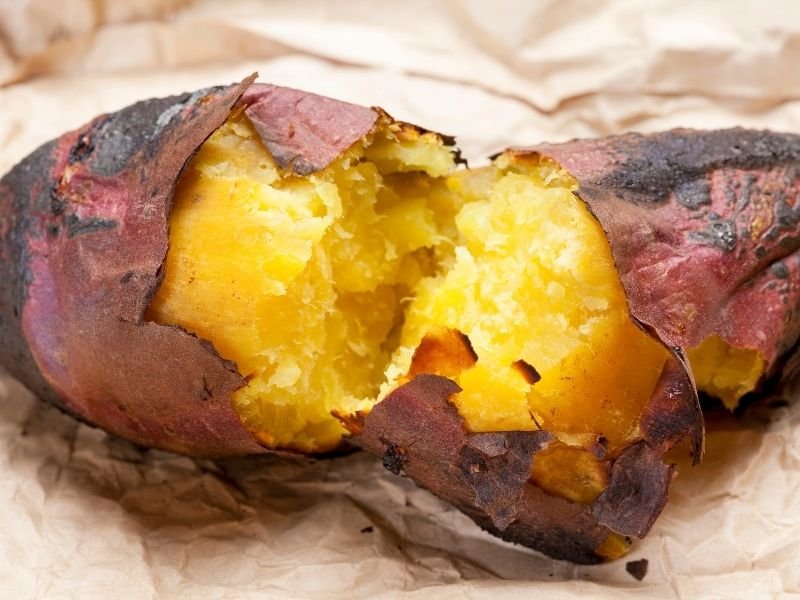
Japanese sweet potatoes are sweeter than American ones, almost like dessert. Try Yakiimo (roasted sweet potato) if you find a street vendor—it’s amazing!
Chitose Ame 千歳飴(Thousand-Year Candy)
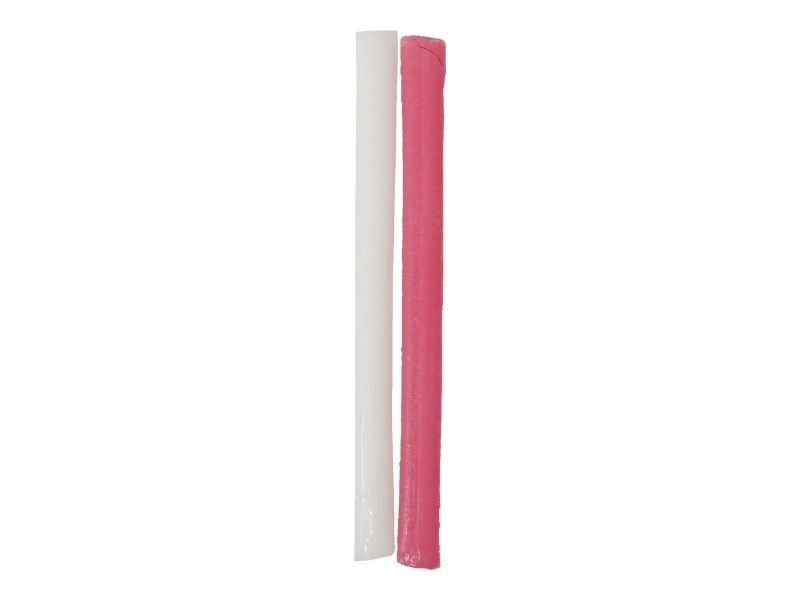

Chitose Ame is a long, thin red-and-white candy given to children during the Shichi-Go-San (七五三) celebration in November. The name means “thousand-year candy,” symbolizing wishes for a long and healthy life.
Shichi-Go-San, which means “Seven-Five-Three,” is a traditional Japanese event to celebrate the growth of children aged 3, 5, and 7. On this day, families dress their children in kimono or formal clothes, visit shrines, and pray for their good health and future.
Chitose Ame is usually sold in cute paper bags decorated with symbols of longevity like cranes and turtles. Even if you’re not traveling with children, it’s a sweet souvenir and a fun way to experience a unique seasonal tradition in Japan!
Tsukimi Burger (McDonald’s Japan Limited Menu)

If you’re traveling in Japan during autumn, don’t miss the Tsukimi Burger at McDonald’s Japan! “Tsukimi” means moon viewing, and this seasonal burger celebrates the autumn moon festival. The burger usually features a juicy patty, smoky bacon, and a fried egg that looks like the full moon, all served with a rich, savory sauce.
Many Japanese people look forward to this burger every year, and it’s become a beloved fall tradition. The Tsukimi Burger usually appears on the menu from early September to early October, and some stores sell out quickly—so grab one while you can! It’s a fun and tasty example of how Japanese McDonald’s adds seasonal flair to familiar food.
You might also spot other limited-time variations like the Cheese Tsukimi or Tsukimi Chicken!
Japanese Seasonal Food InWinter (December–February)
Winter food in Japan is warm, hearty, and comforting. It’s the season for hot pots, sweet citrus, and cozy meals with family.
Shun-Food in Winter
Buri 鰤 (Yellowtail)
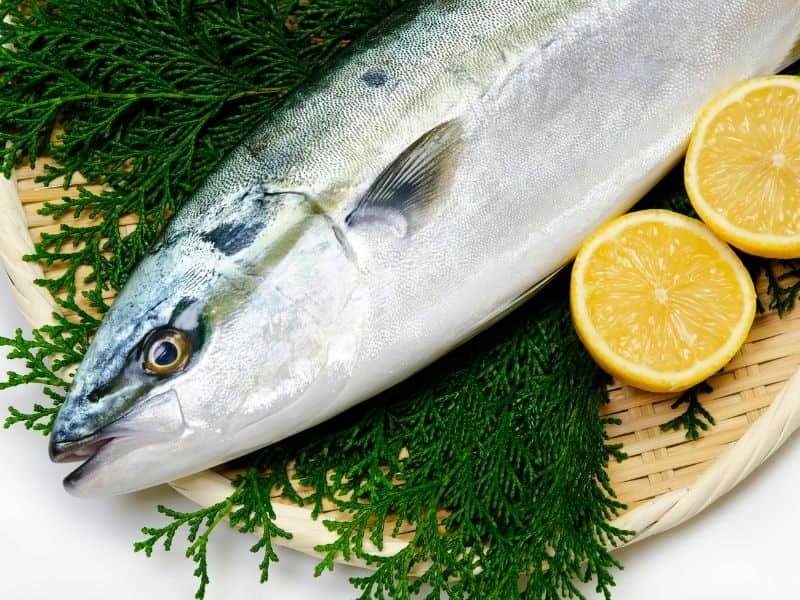
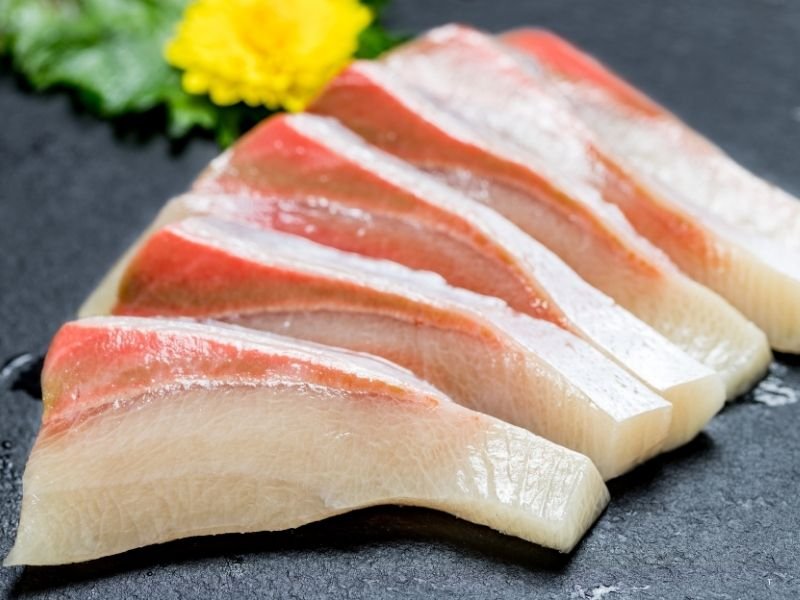
Buri is a rich, fatty fish that’s especially delicious in winter. It’s often served grilled (buri teriyaki), as sashimi, or simmered with daikon in a dish called buri daikon(ぶり大根). The fat content increases as the weather gets colder, making winter the best time to enjoy this flavorful fish.
If you’re traveling to the Hokuriku region, especially Himi in Toyama Prefecture, don’t miss the chance to try Himi Buri! This area is famous for its high-quality yellowtail, caught fresh from the Sea of Japan. The fish is tender, oily (in a good way!), and absolutely delicious.
Many locals look forward to eating buri in winter, and you should too if you’re visiting Japan during this season!
Fugu 河豚 (Pufferfish)
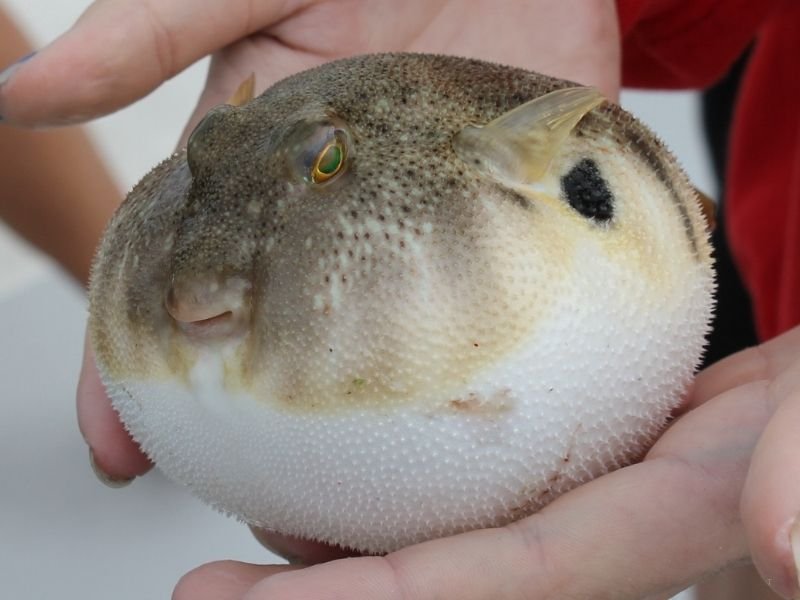
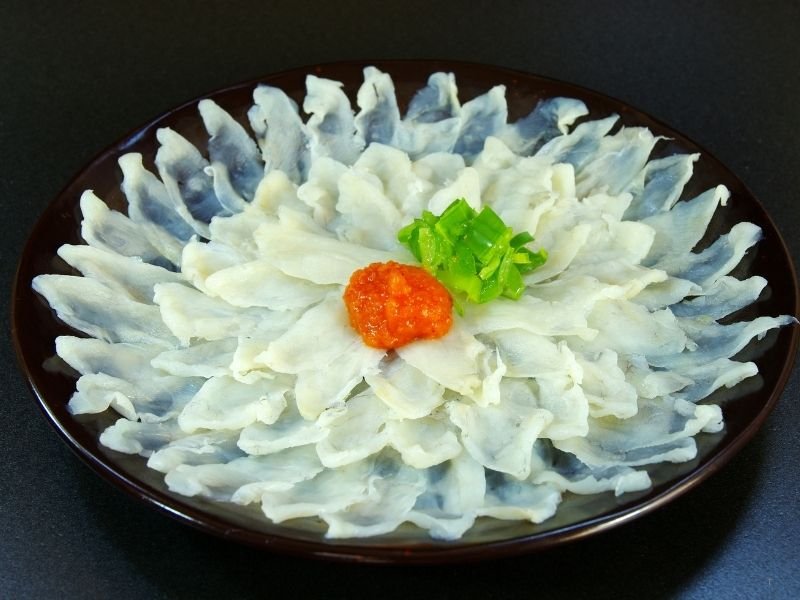
Fugu is a unique and luxurious winter delicacy in Japan. It’s known for its delicate flavor and slightly chewy texture. Fugu can be served in various ways—thinly sliced sashimi (てっさtessa), hot pot (河豚鍋fugu nabe), or even deep-fried (唐揚げkaraage).
Because some parts of the fish are poisonous, fugu must be prepared by specially licensed chefs, which makes eating it both safe and exciting for adventurous food lovers.
If you’re planning a trip to western Japan, especially to Shimonoseki in Yamaguchi Prefecture, this is the place to try fugu! Shimonoseki is known as Japan’s “Fugu Capital”, and the local restaurants there serve some of the freshest and best-quality fugu in the country. Some places even offer fugu tasting courses at reasonable prices during winter.
Trying fugu in Shimonoseki is a truly Japanese experience you’ll never forget!
Mikan みかん (Tangerines)
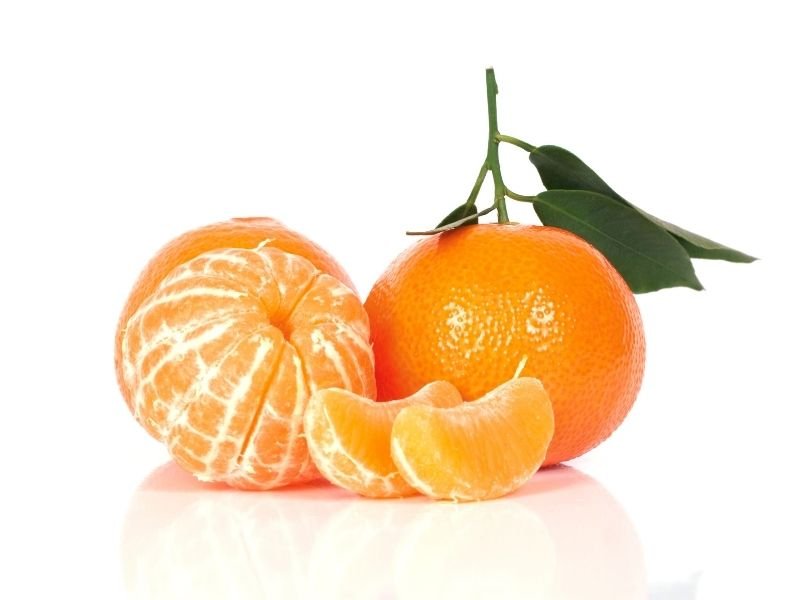
Japan’s favorite winter citrus fruit. Often enjoyed while relaxing under a heated kotatsu table.
We can buy tangerines in the USA, but the Japanese ones are softer and sweeter, I think. Please try if you find it at the supermarkets in Japan.
Seasonal Traditional Foods in Winter
Osechi Ryori (お節料理)
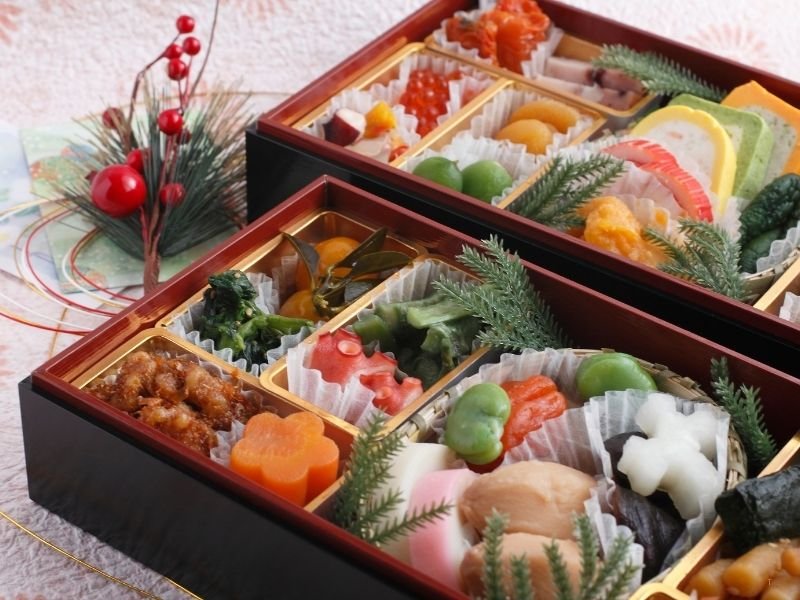
Traditional New Year’s dishes, beautifully arranged in boxes. Hard to find in restaurants, but some ryokan or hotels serve them. Includes items like sweet black beans (kuromame), mashed sweet potato with chestnuts (kurikinton), and fish cakes (kamaboko).
Ozoni お雑煮
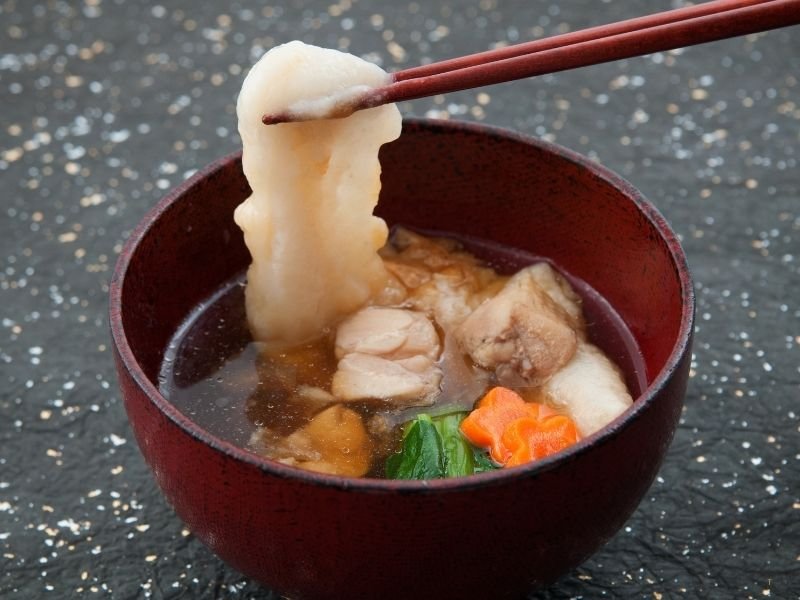
Soup with mochi, eaten on New Year’s Day. Ingredients vary by region.
Oden おでん
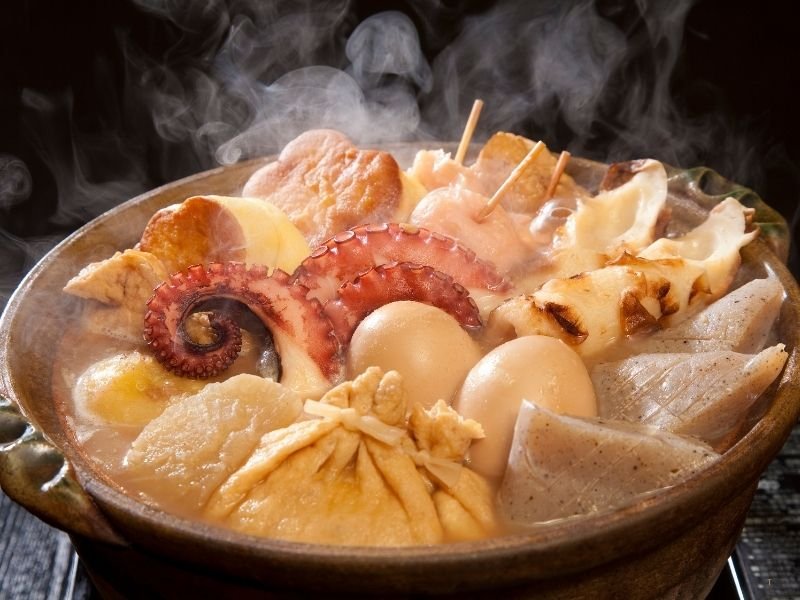
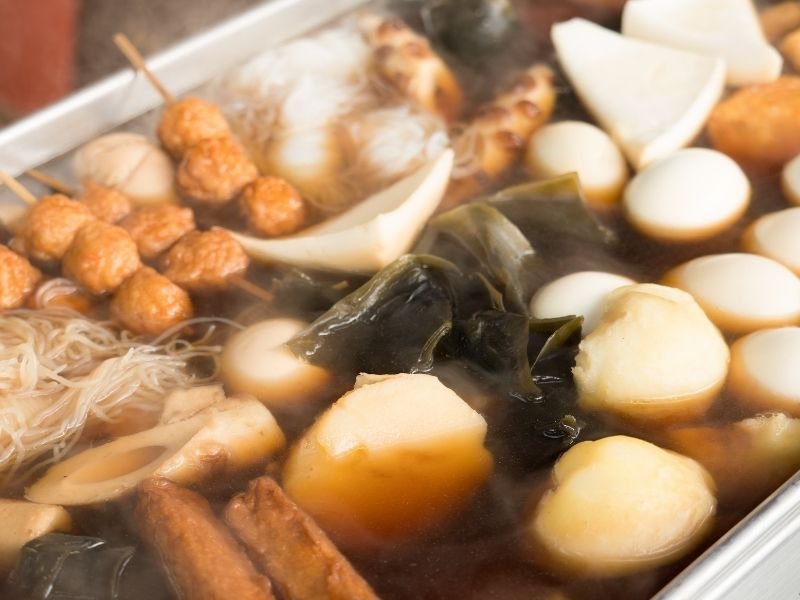
Hot pot with daikon, boiled eggs, konnyaku, and more. You can find it in convenience stores in winter!
Nabe 鍋
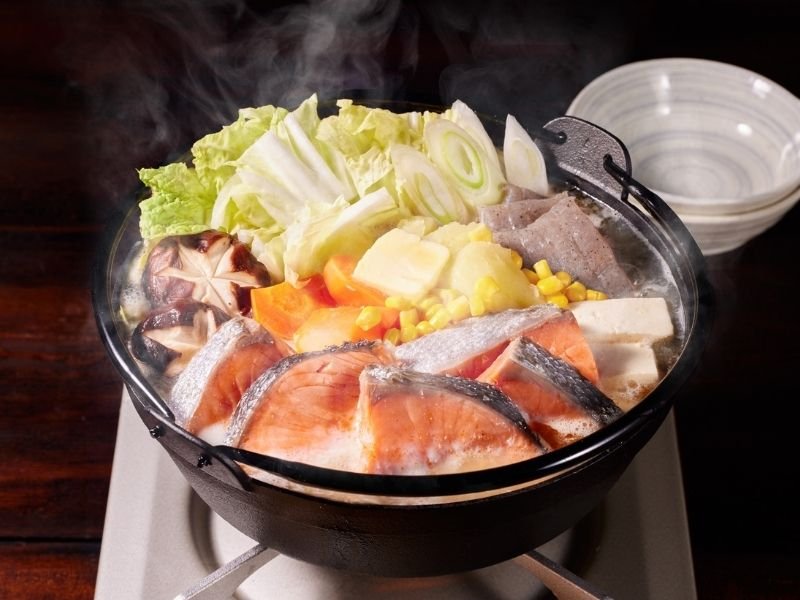
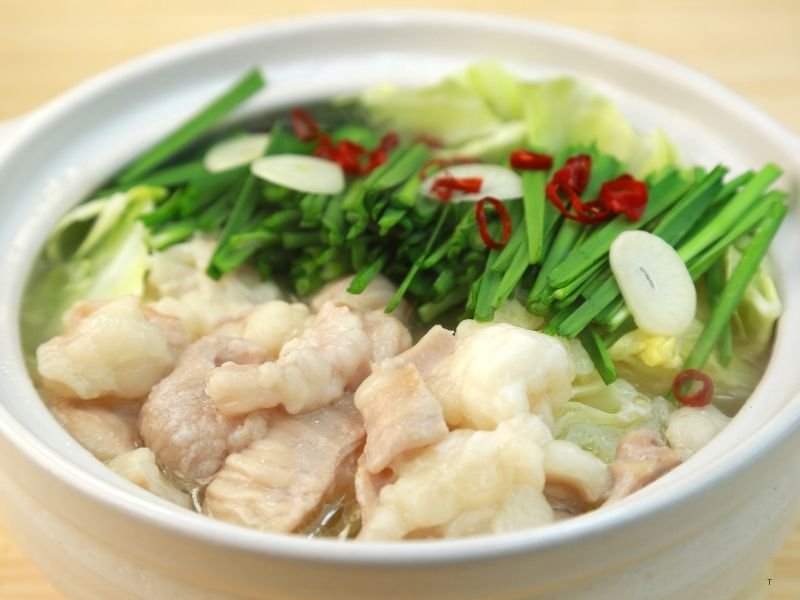
Nabe is a classic Japanese winter dish where ingredients like vegetables, tofu, meat, and seafood are simmered together in a flavorful broth. It’s warm, comforting, and perfect for cold weather—a true favorite among locals during winter!
What makes nabe even more interesting is that it varies by region. Each area of Japan has its own special hot pot recipes based on local ingredients and tastes. For example:
- Chanko Nabe – A hearty, protein-packed hot pot eaten by sumo wrestlers, especially popular in Tokyo.
- Ishikari Nabe – A miso-based salmon hot pot from Hokkaido. (See left side picture)
- Motsu Nabe – A flavorful offal hot pot from Fukuoka, rich in garlic and cabbage. (See right side picture)
- Kiritanpo Nabe – A specialty from Akita with mashed rice sticks and chicken.
- Anko Nabe – A deep-flavored hot pot made with monkfish, common in coastal areas in winter.
You’ll often find regional nabe dishes served at local restaurants, izakaya, or ryokan, especially during winter months. If you’re visiting Japan in the colder season, trying a local nabe is a delicious way to experience regional food culture!
Fukumame 福豆(Fortune Beans)
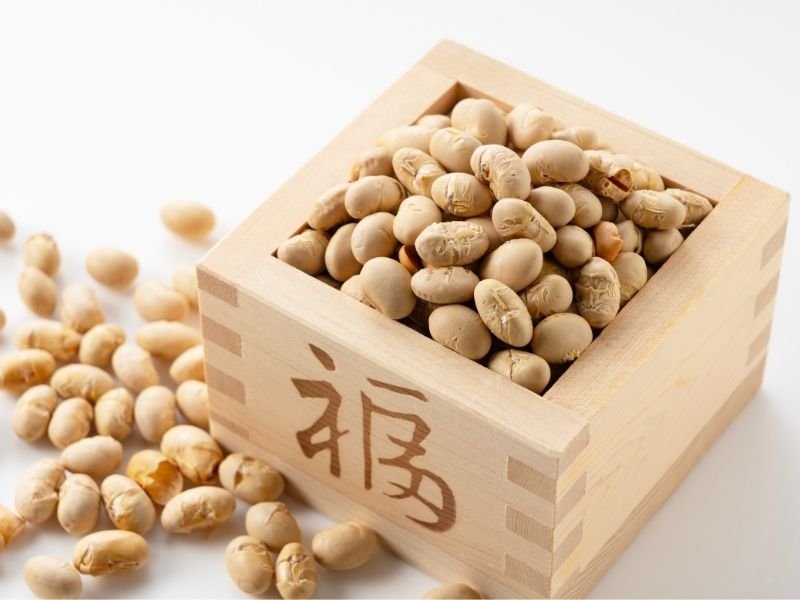

Eaten during Setsubun in early February. You throw roasted soybeans while saying “Oni wa soto! Fuku wa uchi!” to chase away bad luck. Then, eat the number of beans equal to your age for health and luck in the new year!
Final Thoughts
Japan’s seasonal foods are more than just meals—they’re part of the country’s culture, traditions, and way of life. Whether you’re tasting sweet strawberries in spring or warming up with a local nabe dish in winter, each season offers something special.
As you travel through Japan, keep an eye out for these seasonal treats—it’s like a delicious treasure hunt waiting to be discovered!
Want to explore more about local dishes across Japan? Don’t miss my full guide to regional food specialties here:
👉 Japanese Food Culture: The Complete Region-by-Region Guide
